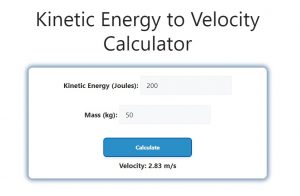About Kinetic Energy to Velocity Calculator (Formula)
The Kinetic Energy to Velocity Calculator is a valuable tool for physicists, engineers, and students studying mechanics. Kinetic energy is the energy that an object possesses due to its motion, and understanding the relationship between kinetic energy and velocity is essential in various applications, such as vehicle dynamics, sports science, and physics experiments. This calculator helps users quickly determine the velocity of an object when its kinetic energy and mass are known, facilitating a better grasp of motion-related concepts.
Formula
The formula for calculating velocity from kinetic energy is:
V = √(2 * KE / M).
How to Use
- Gather Data: Determine the kinetic energy (KE) of the object and its mass (M).
- Input Values: Enter the values of kinetic energy and mass into the calculator.
- Calculate: Apply the formula to compute the velocity (V).
- Analyze Results: Review the calculated velocity to understand the object’s motion characteristics.
Example
Let’s say an object has a kinetic energy of 200 Joules and a mass of 50 kilograms.
Using the formula:
V = √(2 * KE / M)
V = √(2 * 200 / 50)
V = √(400 / 50)
V = √8
V ≈ 2.83 m/s
In this example, the velocity of the object would be approximately 2.83 meters per second.

FAQs
- What is kinetic energy?
Kinetic energy is the energy an object has due to its motion, calculated using the mass and velocity of the object. - How is kinetic energy related to velocity?
Kinetic energy increases with the square of the velocity; thus, even small changes in velocity can lead to significant changes in kinetic energy. - What units are used for kinetic energy and mass?
Kinetic energy is typically measured in joules (J), while mass is measured in kilograms (kg). - Can this calculator be used for any object?
Yes, the calculator can be applied to any object, provided the kinetic energy and mass are known. - What is the significance of the velocity calculated?
The calculated velocity helps in understanding how fast an object is moving and can inform decisions in engineering and safety. - What happens to kinetic energy if mass increases?
If mass increases while keeping velocity constant, the kinetic energy will increase because kinetic energy is directly proportional to mass. - Is there a limit to the kinetic energy that can be input?
There is no strict limit, but the values should be realistic based on the context of the problem being analyzed. - Can I calculate negative velocities using this formula?
Velocity is a vector quantity and can be negative if considering direction; however, the kinetic energy itself cannot be negative. - How do I find kinetic energy if I only have velocity?
You can rearrange the kinetic energy formula: KE = 0.5 * M * V^2 to find kinetic energy if you have the velocity and mass. - What are some applications of kinetic energy calculations?
Applications include vehicle safety assessments, sports performance analysis, and understanding motion in mechanical systems. - Can this calculator be used in educational settings?
Yes, it is an excellent resource for physics students to understand the relationship between kinetic energy and velocity. - What are some common misconceptions about kinetic energy?
One common misconception is that kinetic energy is directly proportional to velocity; it is actually proportional to the square of velocity. - Does this calculator account for air resistance?
No, this calculator assumes a frictionless environment and does not account for external forces like air resistance. - How can I improve my understanding of kinetic energy concepts?
Reading physics textbooks, conducting experiments, and using calculators like this can enhance understanding. - What is the role of velocity in sports science?
Velocity plays a critical role in evaluating athlete performance and the dynamics of sports equipment. - Can this calculator be used for large-scale objects, like vehicles?
Yes, it is applicable for both small and large objects, as long as the mass and kinetic energy are known. - What should I do if the velocity seems unreasonable?
Check the input values for accuracy, and ensure they are realistic based on the object’s characteristics. - Can this calculator assist in vehicle design?
Yes, understanding the kinetic energy and resulting velocity can help in designing safer and more efficient vehicles. - What kind of experiments can I perform with kinetic energy and velocity?
You can perform experiments involving rolling balls, swinging pendulums, or projectile motion to observe kinetic energy in action. - Is there an online version of this calculator?
Many educational websites and physics tools offer online versions of kinetic energy calculators for convenience.
Conclusion
The Kinetic Energy to Velocity Calculator is a practical tool for anyone looking to understand the dynamics of motion. By providing a straightforward way to calculate velocity from kinetic energy, this calculator enhances comprehension of fundamental physics principles. Regularly using this tool can deepen insights into various applications, from engineering to sports science, ultimately contributing to better decision-making and understanding of motion.